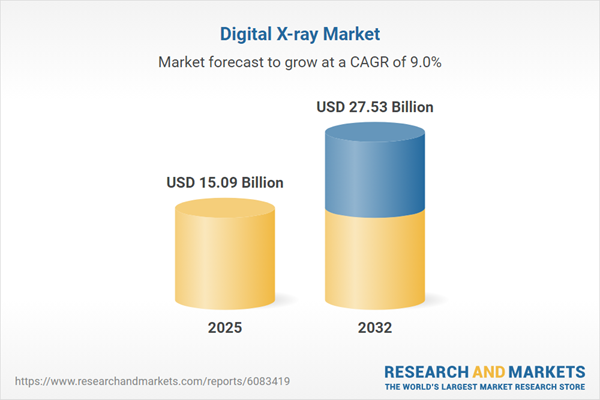Speak directly to the analyst to clarify any post sales queries you may have.
The digital X-ray market is evolving rapidly as hospitals and clinics adopt advanced technologies to streamline diagnostic workflows, bolster efficiency, and elevate patient outcomes. Senior leaders require a concise view of this market’s landscape to make data-driven investment and strategy decisions.
Market Snapshot: Digital X-ray Market Size and Growth Outlook
The digital X-ray market grew from USD 13.85 billion in 2024 to USD 15.09 billion in 2025. It is expected to continue growing at a CAGR of 8.96%, reaching USD 27.53 billion by 2032. This robust trajectory reflects heightened demand for high-precision imaging solutions that optimize clinical workflows and enhance operational resilience across diverse healthcare settings.
Scope & Segmentation: Comprehensive Market Coverage
This report delivers an in-depth assessment of the digital X-ray market, covering critical segments, geographies, and advanced technologies that shape strategic opportunities for stakeholders.
- Technology: Computed Radiography, Direct Flat Panel, Indirect Flat Panel
- Product Type: Fixed Systems (Ceiling Mounted, Floor Mounted, Wall Mounted), Mobile Systems (Trolley Mounted), Portable Systems (AC Powered, Battery Operated)
- Application: Dental Imaging, General Radiography, Mammography, Orthopedic Imaging, Veterinary Imaging
- End User: Ambulatory Surgical Centers, Dental Clinics, Diagnostic Imaging Centers, Hospitals, Veterinary Clinics
- Portability: Fixed, Handheld, Mobile
- Region: Americas (United States, Canada, Mexico, Brazil, Argentina, Chile, Colombia, Peru), Europe, Middle East & Africa (United Kingdom, Germany, France, Russia, Italy, Spain, Netherlands, Sweden, Poland, Switzerland, United Arab Emirates, Saudi Arabia, Qatar, Turkey, Israel, South Africa, Nigeria, Egypt, Kenya), Asia-Pacific (China, India, Japan, Australia, South Korea, Indonesia, Thailand, Malaysia, Singapore, Taiwan)
- Leading Companies: Siemens Healthineers AG, GE HealthCare Technologies Inc., Canon Medical Systems Corporation, Koninklijke Philips N.V., Fujifilm Holdings Corporation, Carestream Health, LLC, Agfa-Gevaert N.V., Hitachi, Ltd., Shimadzu Corporation, Konica Minolta, Inc.
Key Takeaways: Actionable Insights for Senior Decision-Makers
- Next-generation digital X-ray solutions integrate advanced imaging sensors and analytics, enhancing workflow automation and diagnostic clarity for modern healthcare teams.
- Wider adoption of artificial intelligence in image analysis is transforming clinical decision-making, with AI-powered tools supporting faster anomaly detection and reducing reader fatigue.
- Strategic partnerships between device manufacturers and software innovators accelerate the rollout of end-to-end imaging ecosystems, supporting seamless interoperability and data management.
- Healthcare providers are gravitating toward flexible financing models such as equipment leasing or outcome-based subscriptions, increasing accessibility to high-value systems and optimizing capital allocation.
- Regulatory emphasis on cybersecurity and interoperability compels manufacturers to prioritize secure firmware, encryption, and standards compliance throughout development cycles.
- Portable and battery-operated digital X-ray systems are expanding access to care in underserved regions, supporting outreach and remote healthcare delivery.
Tariff Impact: Navigating US Trade Policies
Recent United States tariffs on digital radiography equipment are intensifying supply chain complexities and raising production costs for market participants. Many manufacturers are re-evaluating vendor relationships and relocating assembly operations to mitigate financial impact. Healthcare providers are adjusting procurement cycles and exploring alternative financing structures to navigate tightened capital budgets, resulting in a market split between cost-sensitive buyers and early adopters of premium technology.
Methodology & Data Sources
This research is grounded in a rigorous process that includes primary interviews with senior executives and radiology department heads, complemented by secondary sources such as peer-reviewed journals, regulatory filings, and trade publications. Analytical techniques incorporate segmentation analysis, trade flow data review, and regional market mapping. All findings undergo cross-validation with expert panels to ensure credibility and actionable value.
The Digital X-ray Market: Why This Report Matters
- Provides clear, actionable insights supporting strategic planning, capital investment, and long-term market positioning amid ongoing technology disruption.
- Offers robust segmentation, regional stack analysis, and regulatory intelligence for a holistic understanding of both risks and opportunities.
- Enables decision-makers to benchmark against top companies and emerging business models, supporting differentiation and competitive advantage in a fast-evolving landscape.
Conclusion
The digital X-ray market demonstrates powerful momentum, driven by technology innovation, market adaptation, and regulatory alignment. This report equips industry leaders with the knowledge to pursue growth opportunities, optimize operations, and make informed strategic choices as the sector evolves.
Table of Contents
3. Executive Summary
4. Market Overview
7. Cumulative Impact of Artificial Intelligence 2025
List of Figures
Companies Mentioned
The companies profiled in this Digital X-ray market report include:- Siemens Healthineers AG
- GE HealthCare Technologies Inc.
- Canon Medical Systems Corporation
- Koninklijke Philips N.V.
- Fujifilm Holdings Corporation
- Carestream Health, LLC
- Agfa-Gevaert N.V.
- Hitachi, Ltd.
- Shimadzu Corporation
- Konica Minolta, Inc.
Table Information
| Report Attribute | Details |
|---|---|
| No. of Pages | 197 |
| Published | October 2025 |
| Forecast Period | 2025 - 2032 |
| Estimated Market Value ( USD | $ 15.09 Billion |
| Forecasted Market Value ( USD | $ 27.53 Billion |
| Compound Annual Growth Rate | 8.9% |
| Regions Covered | Global |
| No. of Companies Mentioned | 11 |









